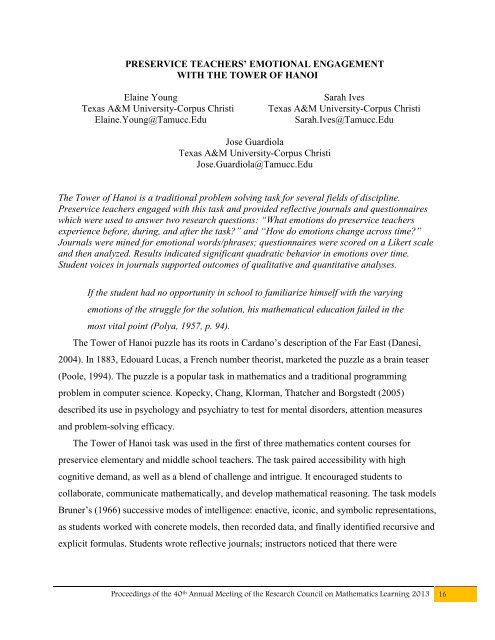2013 Conference Proceedings - University of Nevada, Las Vegas
2013 Conference Proceedings - University of Nevada, Las Vegas
2013 Conference Proceedings - University of Nevada, Las Vegas
- No tags were found...
Create successful ePaper yourself
Turn your PDF publications into a flip-book with our unique Google optimized e-Paper software.
PRESERVICE TEACHERS’ EMOTIONAL ENGAGEMENTWITH THE TOWER OF HANOIElaine YoungTexas A&M <strong>University</strong>-Corpus ChristiElaine.Young@Tamucc.EduSarah IvesTexas A&M <strong>University</strong>-Corpus ChristiSarah.Ives@Tamucc.EduJose GuardiolaTexas A&M <strong>University</strong>-Corpus ChristiJose.Guardiola@Tamucc.EduThe Tower <strong>of</strong> Hanoi is a traditional problem solving task for several fields <strong>of</strong> discipline.Preservice teachers engaged with this task and provided reflective journals and questionnaireswhich were used to answer two research questions: “What emotions do preservice teachersexperience before, during, and after the task?” and “How do emotions change across time?”Journals were mined for emotional words/phrases; questionnaires were scored on a Likert scaleand then analyzed. Results indicated significant quadratic behavior in emotions over time.Student voices in journals supported outcomes <strong>of</strong> qualitative and quantitative analyses.If the student had no opportunity in school to familiarize himself with the varyingemotions <strong>of</strong> the struggle for the solution, his mathematical education failed in themost vital point (Polya, 1957, p. 94).The Tower <strong>of</strong> Hanoi puzzle has its roots in Cardano’s description <strong>of</strong> the Far East (Danesi,2004). In 1883, Edouard Lucas, a French number theorist, marketed the puzzle as a brain teaser(Poole, 1994). The puzzle is a popular task in mathematics and a traditional programmingproblem in computer science. Kopecky, Chang, Klorman, Thatcher and Borgstedt (2005)described its use in psychology and psychiatry to test for mental disorders, attention measuresand problem-solving efficacy.The Tower <strong>of</strong> Hanoi task was used in the first <strong>of</strong> three mathematics content courses forpreservice elementary and middle school teachers. The task paired accessibility with highcognitive demand, as well as a blend <strong>of</strong> challenge and intrigue. It encouraged students tocollaborate, communicate mathematically, and develop mathematical reasoning. The task modelsBruner’s (1966) successive modes <strong>of</strong> intelligence: enactive, iconic, and symbolic representations,as students worked with concrete models, then recorded data, and finally identified recursive andexplicit formulas. Students wrote reflective journals; instructors noticed that there were<strong>Proceedings</strong> <strong>of</strong> the 40 th Annual Meeting <strong>of</strong> the Research Council on Mathematics Learning <strong>2013</strong> 16




